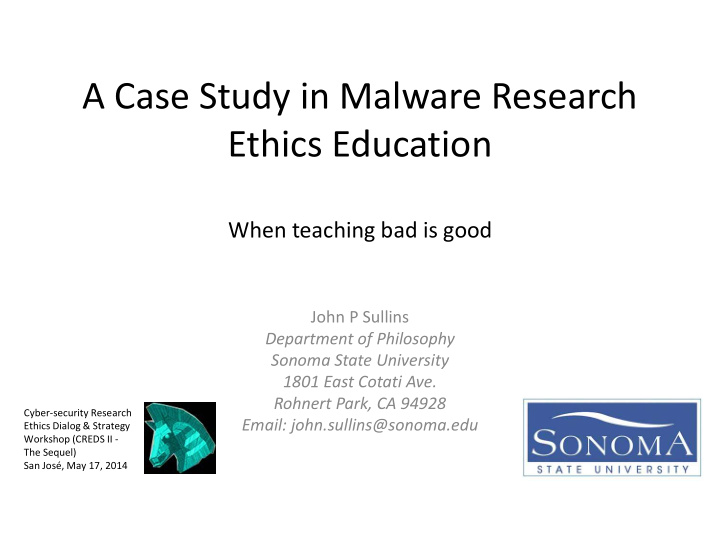



A Case Study in Malware Research Ethics Education When teaching bad is good John P Sullins Department of Philosophy Sonoma State University 1801 East Cotati Ave. Rohnert Park, CA 94928 Cyber-security Research Email: john.sullins@sonoma.edu Ethics Dialog & Strategy Workshop (CREDS II - The Sequel) San José, May 17, 2014
Introduction Academic malware • research is on the rise Professor George Ledin, • SSU John Aycock, Calgary • presentation outline topics in ethics presented • in the class How they are presented • and assessed rationale for requiring • students to keep ethical norms in mind as they do their research projects involving malware design The team behind the SSU malware research course. The Author, George Ledin, and Roger Mamer. http://www.sonoma.edu/insights/archive/08 fall/malware_class.shtml
MALWARE ETHICS
Background and Research Collaboration • Malware Ethics has been slow to emerge – Oxymoron for ethicists • On the other hand… – George Ledin • Must know the enemy to defeat them – John Aycock • Malware can be ethically and artistically designed – And others • Teaching malware is a public good
Ethical Problems in the Study of Malware • Human Subjects – “No worse off” – Problems with IRB • Malware and Information Ethics – Recording data and informed consent – Communicating dangerous findings – Synthesizing or acting on data in unethical ways
CASE STUDY—A COURSE IN MALWARE ETHICS
Rationale • Traditional computer ethics – Some help here • Medical ethics – Some help also but mostly it is too specific to medicine • We must rethink ethics SSU computer science student Ben Corr demonstrates for for the milieu of fellow students his project, which attempts to bypass security and gain access to a computer set up in class. (MARK ARONOFF / PD) malware http://www.pressdemocrat.com/article/20070522/news /705220312
Basic Ethics Concepts Taught • Start with ACM Code of • Some of my influences (In no Ethics particular order of importance ) – But malware research quickly contradicts these rules • Greatest hits in ethics James Moor John Dewey Deborah Johnson – Utilitarianism – Deontology – Human rights – Unified common goods Mario Bunge approach of James Moor Luciano Floridi – Virtue ethics – Information ethics Charles Ess Terrell Ward Bynum And many more…
Virtues in Security • Virtue is culturally • Some of my influences in dependent this area – What are virtues in the security community? • Professional virtues • Software virtues – CIA » Confidentiality Mariarosaria Taddeo Shannon Vallor » Integrity » Availability • We critique – Firewall illusion – Data level security – Personal encryption – Cyberwarfare ethics
Ethical Hacks Students are not treated as passive • receptors of ethical thought – Active agents creating new ethical norms – Building ethical commitments to each other and society – Therefore we focus on personal motivations – Personal codes of conduct are more important and decisive than any institutionally produced code of ethics Assessments • – Discussion and reflection Student Lincoln Peters sits at the helm of a closed network of four operating – Quizzes systems which are used to test malware – Ethical warrants analysis on projects he has designed. Photo by Roger Mamer. – Personal ethos statement http://www.sonoma.edu/insights/archi ve/08fall/malware_class.shtml
Conclusions • Must not overlook ethics in malware research • Teach ethics early on • Focus on special challenges of malware research • Keep it personal • We are an example of a successful implementation of these Student Mike Drew demonstrates the workings of a ideas "Honeypot," a system on the Internet that is expressly set up to attract and "trap" people who attempt to penetrate other people's computers. http://www.sonoma.edu/insights/archive/08fall/malware_class. shtml
Recommend
More recommend